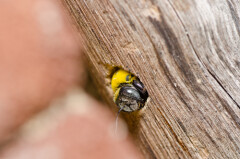What to Know About Carpenter Bees
What Are Carpenter Bees?
Carpenter bees are larger than bumblebees – about a half-inch to 1 inch long – and lack yellow striping. As their name implies, carpenter bees (specifically the females) burrow into soft wood to lay their eggs. These solitary bees are major pollinators, and they love pollen and nectar. Because of their hefty size, carpenter bees are able to vibrate blooms and dislodge stubborn pollen, a technique called “buzz” pollination, which is critical for many food crops. At the same time, these top-notch pollinators can become a major nuisance.
Are Carpenter Bees Destructive?
Yes, carpenter bees are very destructive. Female carpenter bees use their mandibles like teeth to "chew" holes into soft wood in a circular pattern so that the tunnels will fit their bodies perfectly. They can drill about 1 inch every 5-6 days. Their nest tunnels can eventually stretch for several feet with multiple egg chambers branching off each main tunnel that act like bee nurseries. Once her job is done, the adult female will die off in July. Females who survive winter may use the very same spot they hibernated in to lay their eggs, further expanding an established nest.
During the mating and egg-laying season, you’re likely to see carpenter bees drilling holes in wooden structures and surfaces on your home. These can could include:
- Eaves
- Fascia boards
- Fence posts
- Deck and porch railings
- Deck ceilings
- Wooden siding
- Swing sets
- Outdoor furniture
These areas are often lightly stained or left untreated and are built using softer woods - such as redwood, cedar, pine, and cypress - which are ideal for carpenter bee excavation. The damage the female is doing can seriously undermine the safety of wooden structures. While the original hole may only be about an inch deep, the tunnel then turns and follows the wood grain for up to six inches and may even branch further. If left unchecked and untreated, carpenter bee tunnels can significantly weaken deck boards, stairs, posts and other structures and surfaces. That could result in injury to you, your family, and guests, or damage to your home’s structure or interior.
Are Carpenter Bees Dangerous?
Because they’re working on building the next generation of bees, the females you encounter will be aggressive, and can sting if they are aggravated or startled. Males, on the other hand, are not equipped with a stinger. They are very territorial though, and you’ll see them chase each other and hover like little drones, staring you down. Don’t worry, they can’t hurt you, they’re just trying to defend their turf.
When Are Carpenter Bees Most Active?
You’re likely to see carpenter bees in April and May, when they emerge from their winter nests to mate and build the current year’s brood. Carpenter bees have a lifespan of about one year, hatching and then emerging in late summer to feed and bulk up for their winter hibernation.
How to Identify a Carpenter Bee Infestation
In spring and early summer, look for wood dust and small round openings in untreated wooden areas. If you see these, then you likely have a carpenter bee infestation. Working with a licensed, professional pest removal company is the best way to handle this insect. Once they are eradicated, seal up any holes that remain and paint any untreated wood to deter the bees in future years.
Cleveland Bee Removal Can Help
You can call Cleveland Bee Removal for an estimate to control these pests on your property. We'll identify what type of bee they are and stop the harmful ones to give your family peace of mind so you can enjoy your summer safely. Contact us today for a free quote!


